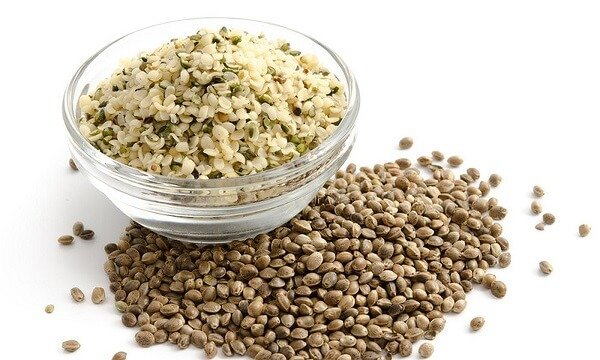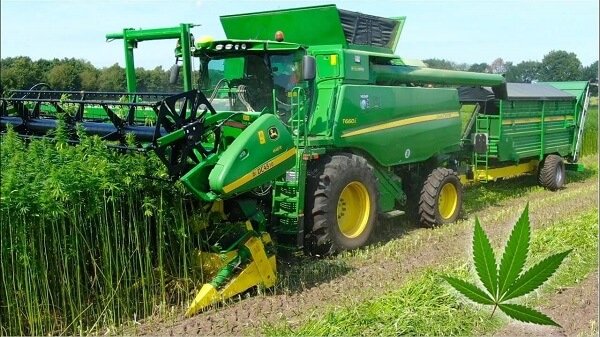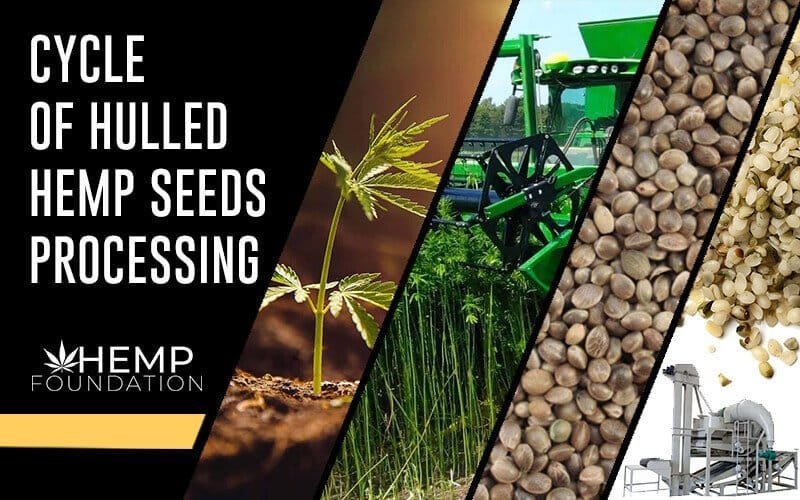[vc_row][vc_column][vc_column_text]Hemp, also known as industrial hemp, is an annual plant that has been in human use for centuries since about 10,000 years ago. It is an herb grown annually for its multifarious uses. It has slender stalks with palmate shaped compound leaves. It has small flowers that are greenish-yellow in color. The pollen-producing flowers grow on the male plants while the flowers that produce the hulled hemp seeds grow on the female plants.

Source: diet-health.info
[/vc_column_text][vc_column_text]Hemp seeds are nuts with a hard outer shell. They are brown in color and the size of popcorn kernels. Inside the shell is a soft, light-green part that usually goes under the name of hemp hearts. Hemp seeds are edible in both versions.[/vc_column_text][vc_column_text]
Variations in Hemp Cultivation
Hemp plants are cultivated differently, depending on the intended use for which they are grown. Plants meant to yield fibers are planted close together and grow into slender plants nearly 2-3 meters tall. That translates to about 6-10 feet. These plants hardly have any branches.
Plants grown for the seeds are placed away from each other. These plants are shorter in height and have many branches. The density difference is considerable. Hemp grown for its edible seeds are planted at a density of a maximum of 1600 plants per acre.
In contrast, a square acre of hemp grown for fibers can contain up to 400,000 plants. Hemp grown, specifically for the production of CBD oil, also follows the lower density cultivation.
There are many processing techniques and equipment necessary for growing hemp and extracting products from hemp seeds. This post discusses the complete cycle of processing hulled hemp seeds as practiced in the US.[/vc_column_text][vc_column_text]
Hemp Seeds: Basic Facts
Hemp seeds are phenomenally rich in nutrients necessary for human health. They constitute one of the most complete plant-based protein sources, Hemp seeds contain all the 10 amino acids essential for the human body. Every 100 grams of hulled or whole hemp seeds contain about 31.56 grams of protein.
The beauty of hemp seeds is that they contain high levels of polyunsaturated fatty acids (PUFAs), which comprise of the good fats that the human body needs. In contrast, their content level of bad fats is exceptionally low. It is also worth mentioning that 100 grams of hulled hemp seeds contain no cholesterol at all.
This nutritional composition makes hemp seeds have proven benefits for cardiovascular health. These seeds have also earned the epithet of miracle seeds because of the ratio of omega 3 and omega 6 fatty acids present in them.
Both these PUFAs are essential for human health, but they interact with each other in different ways. As a result, a combination of one part of omega 3 fatty acids with three parts of omega 6 fatty acids are ideal for human beings, medical science says.
Hemp seeds contain both these fatty acids in those exact proportions. They are also rich in vitamins A and E, and several minerals essential for a healthy human body. Edible in both forms, the only difference between hulled (whole) hemp seeds and dehulled (shelled) hemp seeds is in the fiber content.
Much of the fiber content is in the hard shells of the seeds. Dehulled hemp seeds thus lose out on the fiber content after shelling.[/vc_column_text][vc_column_text]
Processing Hemp Seeds
There is long-drawn processing involved in the harvesting of hemp plants meant for the use of their seeds, and making those hemp seeds available for consumption. Just as there are differences in the cultivation style of hemp grown for fibers and hemp grown for seed use – there are variations in their harvesting also.[/vc_column_text][vc_column_text]
Harvesting the Seeds
The target production of seeds per acre in hemp grown specifically for seed use is about 20-25 pounds. That comes at the rate of about 100-125 seeds per square meter, which can hold 10 to 12 plants.
The harvesting of hemp meant for seed use usually starts when the plants are about 16 weeks old. October is the month when hemp harvesting for seeds normally happens in the US. However, all the seeds do not mature together.
Often, seeds nearer the ground mature before those higher up. Examining the plants carefully is necessary, therefore, to optimize the seed yield. It is important to cut off the top of the plants just below the level of the lowest seed cluster. Warm, sunny days are best for hemp seed harvesting.[/vc_column_text][vc_column_text]
The Hemp Harvester
An equipment known as the combine gets used in the harvesting of hemp grown for fibers. A combine with a dual cutter is also used sometimes for harvesting hemp cultivated for the use of its seeds. However, it is more common to use a machine known as the hemp harvester.
The hemp harvester is a machine adapted from the tobacco harvester. It adapts itself easily to match the lower height of hemp grown for the use of its seeds. The main advantage of the hemp harvester is that it does not destroy the structure of the plant.[/vc_column_text][vc_column_text]
Source: i.ytimg.com
[/vc_column_text][vc_column_text]Of course, the manual method of using a sickle to cut the plants is also possible. But it hardly gets used these days for commercial crops. However, if you have a small personal garden of hemp, a sickle is the best tool to use for harvesting the seeds.[/vc_column_text][vc_column_text]
Separating the Seeds
It is possible to separate the seeds from the stem both manually and mechanically. You’ll need a tarpaulin sheet for separating the seeds manually. In case you do not have one, you can use a large bed-sheet as well. You will need a flat piece of easy-to-wield wood as well.
Make sure you spread out your sheet in an open area, or in a room with windows open for enough airflow. Hold bunches of the cut plants just below the lowest seed cluster with your less active hand. Hold them on the tarpaulin or bedsheet.
With your more active hand, hit the stems with the flat wooden piece. A small cricket bat is good for this also. The seeds will separate from the stalks as you hit them. Make sure you hit every bunch of stalks till all the seeds have separated.
If you have a large commercial crop to take care of, mechanical threshers are your answer. Threshers for separating hemp seeds are available in various sizes with different capacities. Choose the one that best fits your needs. [/vc_column_text][vc_column_text]
Winnowing the Seeds
If you are doing it all manually, one of the simplest ways of winnowing the seeds for a cleaner final collection is to use two buckets. Determine the size of the buckets on the basis of the quantity of seeds you have collected.
Pour the seeds from a marginal height from one bucket to another. The remnants of the stalks will blow away as you do this. Keep repeating the process until all the stalk remnants have been eliminated.
Strainers with a metallic mesh suitable for winnowing hemp seeds are also available. But for a large yield of commercial crops, mechanical winnowers are certainly the best choice. Like threshers, winnowing machines are all available with varying capacities to suit your needs. [/vc_column_text][vc_column_text]
Hulling or Shelling the Seeds
Hulled or whole hemp seeds are edible. For some uses such as hemp coffee, only whole hemp seeds can be used. However, because of their hard exterior, it is more common to use dehulled or shelled hemp seeds for dietary purposes.
It is common to use shelling machines to get the soft inner kernel known as hemp hearts. A wide range of shelling machines is easily available in the online marketplace to suit varied needs.[/vc_column_text][vc_column_text]
Sources:
Cannabis sativa, Indian hemp
Seeds, hemp seed, hulled
Harvesting Hemp[/vc_column_text][/vc_column][/vc_row]

